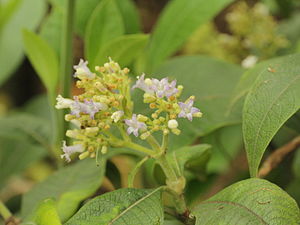Buddleja incana
| Buddleja incana | ||||||||||||
|---|---|---|---|---|---|---|---|---|---|---|---|---|

Buddleja incana |
||||||||||||
| Systematics | ||||||||||||
|
||||||||||||
| Scientific name | ||||||||||||
| Buddleja incana | ||||||||||||
| Ruiz & Pav. |
Buddleja incana is a plant of the genus Buddleia ( Buddleja ) in the family of Figworts (Scrophulariaceae). It is native to the Andes .
description
Vegetative characteristics
Buddleja incana grows as a tree that reaches heights of 7 to 15 meters. The bark of the branches is hairy whitish. The leaves are elongated, lanceolate and slightly toothed. The stipules are margined.
Generative characteristics
Many flowers stand together in head-shaped inflorescences. The flowers are four-fold with a double flower envelope . The cup is serrated. The white to yellow corolla is open.
Common names
In Quechua the type is called kiswar (so in all dialects of Peru and Bolivia), in Kichwa Ecuador kishwar and in Aymara kiswara . The Spanish names quisoar, quisuar and quishuar (pronounced: kisuar) are derived from this. However, these names are also used for other summer lilac species - sometimes in combinations such as puna kiswar ( Buddleja coriacea ) . To distinguish it, Buddleja incana is also known as hatun kiswar ("large buddleia") in view of its relative size .
distribution
Buddleja incana grows in the Andes ( Bolivia , Peru , Ecuador and Colombia ) at an altitude of 2500 to 3600 meters, which, according to Javier Pulgar Vidal , corresponds to the Quechua high altitude zone .
Kiswar was the most important forest tree at the time of the Inca (mallki as opposed to sach'a trees that grew in the wild ) . Since then, the stock of kiswar has declined sharply due to its use for firewood, construction timber and overgrazing . Place names in the Andean region testify to the tree's former occurrence in areas where it can no longer be found today.
Buddleja incana , together with also indigenous Polylepis and Escallonia species, Schinus molle and Buddleja coriacea, is intended for reforestation measures in the Andean region.
use
Buddleja incana is valued for its particularly hard wood , from which tools are traditionally made, such as "foot plows" ( chakitaklla ), but also spoons and trowels or bowls for making chicha . The Incas also carved ceremonial objects such as figures and wooden cups ( qiru ), which were sometimes burned in large numbers as offerings.
The leaves are traditionally used to make compresses for toothache; their infusion serves as a diuretic . The flowers are traded under the name Flor blanca (directly translated "white flower") as a natural remedy for vaginal discharge .
Systematics
The first description of Buddleja incana was in 1798 by the Spanish botanists Hipólito Ruiz López and José Antonio Pavón y Jiménez . Synonyms for Buddleja incana Ruiz & Pav. Are: Buddleja bullata Kunth , Buddleja incana var. Pannulosa Diels, Buddleja longifolia Kunth, Buddleja rugosa Kunth.
Individual evidence
- ↑ a b c d e Daniel W. Gade: Nature and culture in the Andes , 1999, p. 62: Deforestation and reforestation of the central andean highlands. The case of the Buddlejas .
- ↑ Fortunato L. Herrera: Contribución a la flora del departamento del Cuzco. , 1921, p. 176 ( PDF. )
- ↑ Systema vegetabilium florae peruvianae et chilensis, anno 1798, auctoribus Hippolyto Ruiz et Josepho Pavon. Tomus primus. Pagina 389.
- ↑ Qheswa simi hamut'ana kuraq suntur: Simi Taqe Qheswa - Español - Qheswa. Qusqu, Piruw 2006. p. 206
- ↑ Teofilo Laime Ajacopa: Iskay simipi yuyayk'ancha. La Paz - Bolivia, 2007.
- ↑ David John Weber et al. (2000): Rimaycuna, Quechua de Huánuco - Diccionario del quechua del Huallaga con índices castellano e inglés. p. 441
- ^ Fabián Potosí C. et al., Ministerio de Educación del Ecuador: Yachakukkunapa Shimiyuk Kamu, Runa Shimi - Mishu Shimi, Mishu Shimi - Runa Shimi. Quito, Ecuador 2009. p. 82.
- ↑ Diccionario Aymara - Español ( Memento of the original from November 20, 2009 in the Internet Archive ) Info: The archive link has been inserted automatically and has not yet been checked. Please check the original and archive link according to the instructions and then remove this notice.
- ^ Louis Girault: Kallawaya - guérisseurs itinérants des Andes. Research on les pratiques médicinales et magiques. Paris 1984. p. 83
- ↑ Pulgar Vidal, Javier: Geografía del Perú; Las Ocho Regiones Naturales del Perú . Edit. Universo SA, Lima 1979. (First publication :) Las ocho regiones naturales del Perú. In: Boletín del Museo de historia natural “Javier Prado” , n ° especial, Lima, 1941, 17, pp. 145–161.
- ^ Yachay Wasi: Million Native Trees Campaign in the Peruvian Andes .
- ↑ Dr. Oscar Villavicencio Vargas: Uso clínico de plantas medicinales. Buddleja incana “flor blanca” . ( Memento of the original from August 20, 2010 in the Internet Archive ) Info: The archive link was automatically inserted and not yet checked. Please check the original and archive link according to the instructions and then remove this notice.
- ↑ Ruiz, Pavon: Flora Peruviana, et Chilensis , 1, p. 52, plate 80, 1798 scanned at biodiversitylibrary.org.
- ↑ Buddleja incana at Tropicos.org. Missouri Botanical Garden, St. Louis, accessed August 25, 2015.
Web links
- Buddleja incana in the Germplasm Resources Information Network (GRIN), USDA , ARS , National Genetic Resources Program. National Germplasm Resources Laboratory, Beltsville, Maryland.
- Buddleja incana at Tropicos.org. In: Bolivia Checklist . Missouri Botanical Garden, St. Louis
- Buddleja incana at Tropicos.org. In: Peru Checklist . Missouri Botanical Garden, St. Louis
- Buddleja incana at Tropicos.org. In: Catalog of the Vascular Plants of Ecuador . Missouri Botanical Garden, St. Louis